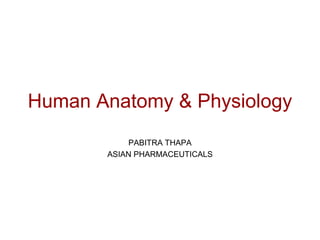The document provides information on human anatomy and physiology, with a focus on the digestive system. It describes the structure and functions of the cells, tissues, organs and body systems. It then discusses the layers, organs and functions of the digestive system in detail. This includes the mouth, salivary glands, esophagus, stomach, small intestine, large intestine, liver and pancreas. It also covers the mechanisms of acid secretion in the stomach and factors that regulate gastric juice production. Finally, it provides an overview of acid peptic disorders like gastritis, GERD, peptic ulcers, and their causes and treatments.



















































![ANZEL
Mechanism of Action
Anzel is a antacid plus anti-gas combination product containing the
unique chemical entity Magaldrate.
Magaldrate is a complex hydroxymagnesium aluminate with the
approximate formula [Mg (OH) +] 4 [Al2(OH)10 4 -].2H2O .It reacts
with acid in stages. The hydromagnesium is relatively rapidly
converted to magnesium ion and the aluminate to hydrated aluminium
hydroxide; the aluminium hydroxide then reacts more slowly to give a
sustained antacid effect.
Simethicone reduces the surface tension of gas bubbles so that the gas
is more easily eliminated.It is a surface active agent and dispenses
foam to diminish gastroesophageal reflux and the dyspeptic
symptoms.](https://image.slidesharecdn.com/anatomydigestivesystem-220323071952/85/ANATOMY-DIGESTIVE-SYSTEM-pptx-52-320.jpg)































